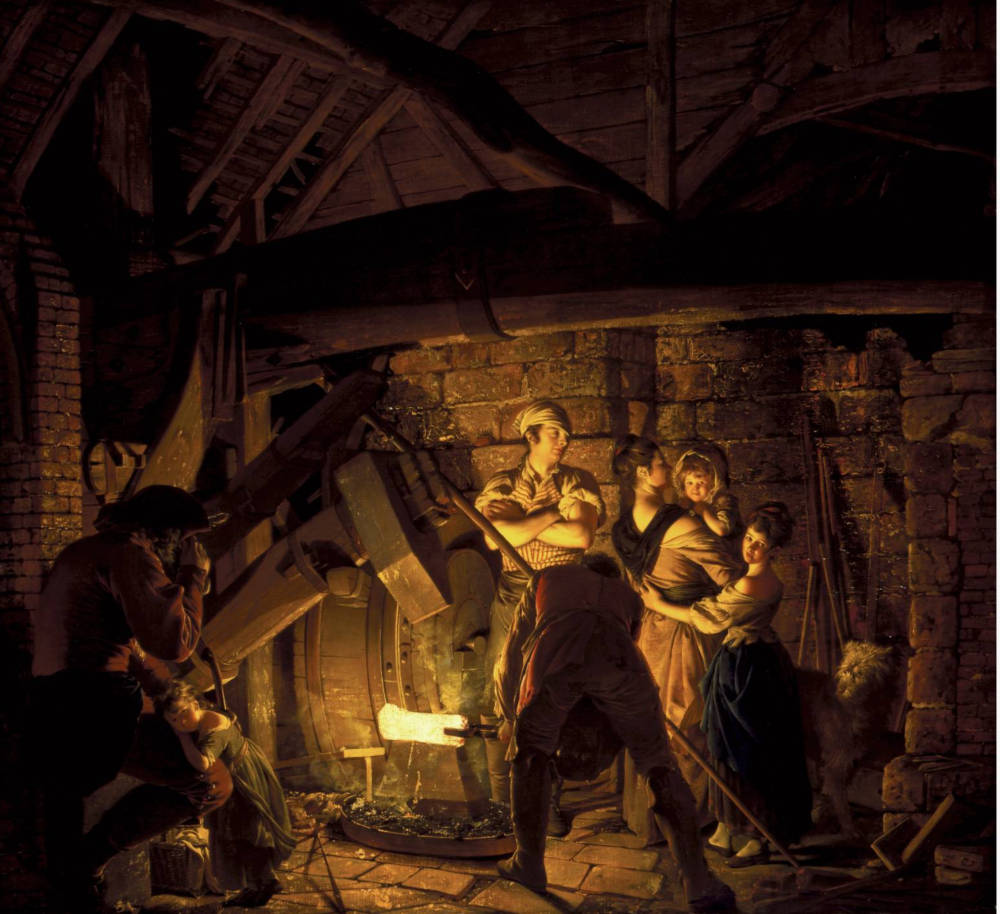
An Iron Forge by Joseph Wright of Derby. 1772. Oil paint on canvas, 1213 x 1320 mm. Collection: Tate Britain T06670. Purchased with assistance from the National Heritage Memorial Fund, the Art Fund and the Friends of the Tate Gallery 1992. Click on image to enlarge it.
This painting is a plate in Hugh Witemeyer’s George Eliot and the Visual Arts.
Tate Britain Commentary by Diane Perkins
Wright was a painter of portraits and subject-pictures who spent most of his life in his birth-place, Derby. From the mid 1760s he began to paint scenes of contemporary scientific and industrial life, of which An Iron Forge is one of the most striking.
Many of his explorations of new inventions and technology were painted as 'night-pieces' with strong contrasting effects of light and darkness. An Iron Forge is one of five 'night pieces' which Wright made between 1771 and 1773, taking as his subject the blacksmiths' shops and forges of Derbyshire. In this scene of a small iron forge at work, an iron-founder and his family are bathed in the warm light cast by a newly forged white-hot iron bar, which has been dragged out of the nearby furnace by an assistant. Wright adapted the scale for dramatic effect, compressing the scene to accommodate the machinery and the figures. In actuality, the heat and sparks would have made their proximity impossible.
The central figure of the picture is the iron-founder, presented in a commanding pose as he pauses in his work to cast a proud eye towards his wife and children. The workman, or 'finer', with his back to the viewer, holds the glowing metal over the anvil with a pair of tongs, ready to be hammered. The iron-founder's role as overseer and his relaxed attitude - even his faintly dandyish striped waistcoat - suggest that the introduction of new machinery in his forge has brought about a lightening of his workload. The combination of his muscular physique and his place amidst his contented family, reinforce the middle-class value of honest labour as a prerequisite to domestic happiness.
Most forges were still family operations and the inclusion of the extended family is not necessarily out of place. However, the presence of the iron-founder's wife and children, one of whom has run to the elderly man seated on the left, suggests that Wright may have deliberately introduced the theme of the 'Ages of Man', showing three generations of the family. The old man appears to be his father, perhaps himself once the smith and a link to the methods of the past.
The power-driven machinery of the forge is as much the hero of this picture as the iron-founder himself. While Wright's slightly earlier paintings of blacksmiths' shops depict a craft that had scarcely changed for centuries, both this painting and An Iron Forge Viewed from Without, 1773 (Hermitage Museum, St Petersburg) show a more modern process, using water-powered forges driving tilt-hammers. Wright illustrates the machinery in the forge very clearly here, showing the large drum which is turned by the water-wheel outside to lift the tilt-hammer beam. The water-powered hammer obviously saved much of the effort seen in the 'blacksmiths' shop' subjects, where the blacksmith himself wields his hammer.
Although this painting is often used as an illustration of the Industrial Revolution, the technology that Wright depicts was not especially advanced. Rather, the modernity of the painting lies in its heroic treatment of a theme from common life. According to the high-minded art theories of the period, such a prosaic scene of ordinary working men did not warrant such a dignified treatment. The extraordinary light effects and dramatic composition endow the scene with an almost religious grandeur, while the subtle allusion to the noble theme of the 'Ages of Man' adds a 'history' element to the subject that is worthy of a 'grand style' masterpiece.
Details of the Painting and Related material
- Water-powered tilt hammer
- Figures at left — little girl and man in shadow
- Mother and children at right
- The Industrial Revolution (homepage/sitemap)
- Water-Powered Drop Forge, Abbeydale Industrial Hamlet, Sheffield, South Yorkshire.
- “Extraordinarily Lop-sided in its effects” — Mechanization & Victorian Work
- The Industrial Revolution: A Timeline
Bibliography
Daniels, Stephen. Joseph Wright. London, 1999.
Nicolson, Benedict. Joseph Wright of Derby. London, 1968.
Witemeyer, Hugh. George Eliot and the Visual Arts. New Haven: Yale University Press, 1979.
Wright of Derby. Exhibition catalogue. London: Tate Gallery, 1990.
Last modified 2 August 2018